Name
Брэст (Brest). This is the Belarusian spelling, but much more common is the almost similar Russian spelling Брест (same pronunciation). Centuries ago, the place was known as Bereste. In some Slavic languages, 'Berest' means 'elm tree', but I am not sure if there is a connection with the place name. An even older name is Берасьце (Bjeras'ze), but this name is out of use. For a long period of time, Brest was ruled by neighbouring Poland. The Polish name for Brest is Brześć. Another common name for the town was Brest-Litovsk (Lithuanian Brest, see history). This was probably to avoid confusion, since there is another bigger town called Brest in Brittany (North-west France).
Location

| ||
| Brest |
Brest is the westernmost town of the →Belarus (White Russia) and stretches along the border to Poland. The town marks a very important frontier train station on the Berlin-Moscow route. To the capital →Minsk in the north-east it's around 350 km, to →Warsaw in the west only 220 km. Around Brest, the river Bug (to be exactly the Western Bug) forms the boundary between the Belarus and →Poland, i.e. it's the eastern border of the European Union. The rather short river Muchavets flows from the east along the southern edge of the town and finally empties into the Bug. Nothing spectacular, if this wouldn't be a part of the Bug-Dnieper Canal (Dnieprovsko-Bugskii Kanal), which was canalised to create the missing navigable section between the Black Sea and the Baltic Sea.
Both rivers are joined by small swamps. There are also some islets in the estuary, which made it a perfect place for erecting a mighty fortress and a town respectively.
Population
Population: In 2004, Brest had around 290,000 inhabitants, making it the sixth-largest town in Belarus and the largest town of Woblast' Brest - one of the six Belarusian districts.
Orientation
Compared to other Belarusian towns, Brest looks a little bit different, although due to the war older buildings, except for the fortress, are missing there, too. The largest part of the town stretches between the Moscow-Berlin rail road in the north and the small river Muchavets in the south. Streets in the centre of town are mostly laid out in a strict chequered pattern. The wide rail road and train station area can only be crossed by either using the one and only large bridge or the small footbridge.
The dead straight street starting from the bridge over the rail road and leading southwards is the main road, called wulitsa Lenina (Lenin rd.). Halfway, the street crosses the ploshcha Lenina (Lenin square) featuring a Lenin monument, the House of the Soviet and a church (see picture on the right). Most street names have not changed after 1991 - there is still the Street of the Komsomol (=Communist Union of Youth), the Soviet street, the Marx-, Engels-, Ordshonikidse-, Kirov- etc. road. The vul. Savetskaya (Soviet rd.) three blocks east of Lenin rd. is the main shopping street of Brest.
The centre itself is rather compact and everything is within walking distance. Only the fortress (see below) is more than 2 km away in the western part of the town. The fortress and the centre are connected by vul. Masherava (former Moskovskaya).
History
Compared to other Belarusian towns, Brest is a rather old town. It was first mentioned as a place called Bereste in the year 1019. However, at that time it was only a small settlement consisting of a couple of blockhouses. This was not about to change during the next centuries - Brest was not one of the most important towns in Eastern Europe. Nevertheless the place was successively raided by Mongols, Slavs, Poles, Lithuanians and so on.
Since 1569, Brest remained under Lithuanian rule. In 1596, the Union of Brest was sealed - a large group of orthodox Christians acknowledged the pope and therefore bridged the gap between the orthodox East and catholic Poland. This is how the Uniate Church was born. During the 17th century, first the Russians and than the Swedes invaded the town, but it still remained under Lithuanian control until 1795 (see also →3rd partition of Poland).
After that, the town belonged to the Russian empire and was used as a fortress. Until 1918, Brest was ruled by Russia. In that year, Lenin and his comrades played for time in order to save the revolution. Therefore they signed the Treaty of Brest-Litovsk. It was a contract between the central powers (Germany, Austria-Hungary) and now bolshevist Russia. As a result of the treaty, Russia lost large parts of its former territory, e.g. the →Ukraine, wide parts of the Baltic states and other territories.
Germany couldn't enjoy the results of the treaty for a very long time - as is known, it lost the war during the same year. Now, the western part of the Belarus including Brest became a part of →Poland until the year 1939, when the German army showed up again at the western banks of the river Bug. Synchronously, the Red Army moved westwards and seized the town again.
Two years later, the Wehrmacht suddenly crossed the river and took the town within a few hours. The whole town? No, a small fortress offered fierce resistance. See below for more information. In 1944, the town was liberated by the Russian army and soon rebuilt. Because of the heroic struggle against the intruders, Brest was declared Hero City. All in all, there were 13 Hero Cities in the Soviet Union (for the protocol: the others were →Kiev, →Odesa, Smolensk, Volgograd (aka Stalingrad), Novorossiysk, Kerch, Sevastopol, Moscow, →Minsk, Tula, Murmansk und St. Petersburg). Today, Brest is a vibrant transit point for travelers and merchants, which didn't change in 2004 when Poland gained full EU-membership.
Getting there / transportation
From Brussels to Irkutsk, from St. Petersburg to Vienna - only very few European cities have such excellent train connections. This is because of the fact that every train running between Berlin and Moscow stops in Brest. All trains stop in Brest for two to three hours to change the wheels so that they fit the wider Ex-Soviet Union gauge (Stalin was afraid that his country might be invaded by train!). Here's a hint from an experienced traveler: It doesn't really worth to step off the train - the train station is often very crowded, chaotic and not easy to navigate. Besides, the time is too short to see something from the city.
For more details on internationa train connections to and from Brest and Minsk see →Belarus: Travel information. Note that the railway service to Hrodna north of Brest has been suspended, leaving the bus as the only option. It's possible to get to →Minsk on one of the international trains bound for Moscow. This takes around 4 hrs, but there's a hefty surcharge. It's much cheaper to take the elektrichka (commuter train), but it's a boring 7 hrs ride going dead straight to the north-east. The fare is 4 Euro only. Taking the night train to Berlin will set you back 70 Euro. The train to →Warsaw (trains bound for Berlin stop there, too) needs 4 hours, the fare is 13 Euro. But there is a hefty 11 Euro extra fee to be paid on the train.
The huge train station area is divided into a northern and a southern part, with a longe station hall in the middle. The northern part with the European standard gauge is for trains running westwards. Before entering the platform, everyone needs to pass customs and emigration. This can take up to 1 hour, so it's better to show up early. We wanted to buy tickets for an international train one day before the departure, but we were told that international tickets can only be purchased the same day or the day before after 9 pm. I don't know whether this rule applies to all trains. The train station also houses several kiosks and exchange booths, a luggage claim and so on. Foreign travelers are often approached by elder women asking to smuggle cigarettes for them to Poland (note that the limit is 10 packages!).
Who is coming to Brest? (well, who is coming to the Belarus, anyway?) The town itself doesn't have much to offer, although it's much more pleasant than let's say →Minsk. There are some orthodox churches in the centre of town as well as buildings from the early 20th century resembling typical Polish towns. All in all I counted three churches. And the centre is quite spacious and green and therefore good for a walk. However, Brest's main claim to fame is definitely the Брестская Крепость (Brestskaya Krepost', at least that's the Russian name) - the Fortress of Brest.
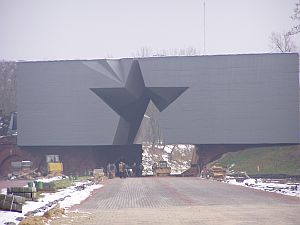
| ||
| Entrance to the large fortress of Brest |
The fortress occupies a large area around the confluence of the rivers Bug and Muchavets. The diameter of the outer fortification ring is quite large (maybe 1 km!?), but large parts of the outer walls were destroyed beyond recognition. The core of the fortress occupies a small island in the river, which is connected to the rest of the structure by three small bridges. The fortress was built between 1838 to 1842. In order to do this, the whole town needed to be moved 2 km eastwards. Thus, the town of Brest as it can be seen today was entirely built after the year 1838. It was during the 1st World War that the fortress played an important role for the first time. For more about this see below.
What is so special about this fortress? There are hundreds of similar fortresses to be found all over Europe, and many of them are in better condition than the one in Brest. On June 22 1941, Hitler surprised the Soviet Union with a breach of the Treaty of Nonaggression. In the early morning hours of the same day, Brest as a frontier town was struck by a massive artillery attack, leaving 90% of the town destroyed. Of course the fortress itself was known to the attackers, and so the entire fortress encountered heavy shelling, too. But the garrison inside the fortress didn't believe in giving up easily and offered fierce resistance. The German attackers decided to besiege the fortress instead of taking it instantly with heavy casualties. A month and a half later - →Minsk was already overrun weeks before and the Wehrmacht was about to take Smolensk in present-day Russia - the invaders finally managed to take the fortress. The remaining soldiers were captured, but as a matter of fact only a handful of them survived the long siege. Needless to say that large parts of the fortress were in ruins then.
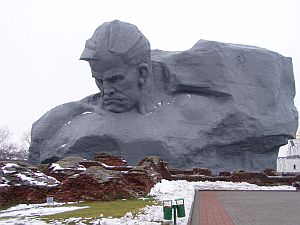
| ||
| The giant sculpture inside the fortress |
That's the way a heroic saga comes into being. Soon after the liberation by the Red Army in 1994, Brest was declared "Hero City" and even received the unique title "Hero fortress". Instead of rebuilding the fortress, politicians decided to create a giant monument. There was no one in the whole Soviet Union who hadn't heard of the heroic struggle of the garrison inside the fortress of Brest. Already the entrance to the memorial is gigantic: A large concrete block was put on the old outer wall, featuring a huge star-shaped tunnel in the middle. After passing the tunnel, visitors pass the second (or third?) fortification ring with some old tanks and bullet-riddled walls. A small bridge leads to the island and therefore to the core of the fortress. A large, shining obelisk, a truly gigantic concrete sculpture shaped as a combatants head and - how strange - an old church dominate the view.
Right in front of the giant sculpture an eternal flame blazes, guarded by four sentries - two women and two men (yes, emancipation!). However, the changing of the guards-ceremony appears to be simply grotesque. I can't find a better attribute to characterise the scenery. The foundation walls of the completely destroyed barracks can be seen next to the eternal flame.
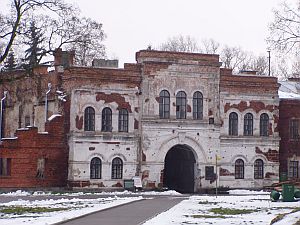
| ||
| One of the fortress gates from the inside... |
The inner island is completely encircled by two-storey brick buildings, from which is more or less left. There is just one building that breaks the ranks - it's the white building left of the sculpture. Inside that building, the fugacious Treaty of Brest-Litovsk was signed in 1918. Thanks to the treaty, imperial Germany could wrest large areas from the revolutionising vast empire in the east - although Germany could not enjoy the newly gained territories for a very long time (see the history chapter above and →History of the Belarus for more details). Unfortunately it is not allowed to enter the White Palace.
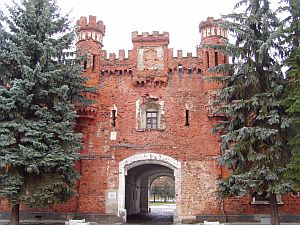
| ||
| ...and from outside |
The white palace marks one of the entrances to the fortress. A small bridge behind the palace leads to another small island. It's worth to turn around after crossing the bridge: The view of the bullet-riddled, red gate is probably the most famous view of the fortress, published on millions of post cards during Soviet times. Compared to other parts of the fortress, the gate and the palace are in a rather good condition, but one can still imagine how fierce combat was in 1941. The parts further to the north look much worse - in some places, only the outer walls are left. Actually it takes some time to find a stone which was not hit by gun fire.
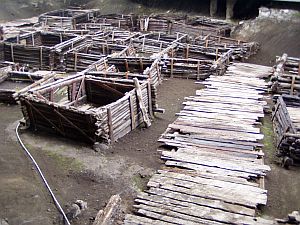
| ||
| The archeological museum next to the fortress |
Only a few dozen metres behind the bridge you will find a large and rather modern hall. Note that all other paths starting from the bridge are off-limits, since this is borderland (nothing less than the NATO border!). The hall houses the Archeological Museum of Brest and was built around a large excavation site. Of course, all explanations are in Russian only, but the excavation site as well as the exhibition are well worth a look and offer the possibility to get away from cruel modern history for a while. Entrance fee for foreigners is 2,100 BYR (0.80 Euro).

| ||
| The church inside the fortress |
All that was left from Old Brest, as it existed before the fortress was built, stands right in the middle of it - just like they've forgotten to move it as well. The church has a golden dome and is known as St Nikolai Church. Obviously, the church was reconstructed during the last years, but inside it looks like nothing was done so far. A pope sells sundry devotional objects such as small plastic ikons etc. inside the church. However, the interior of the is quite a surprise: it strongly resembles a mosque or, to be more exactly, Byzantine architecture. This might be because of the low candelabrum and the shape of the vault - anyway, the church is something one wouldn't expect in this "Hero Fortress".
Apart from the above-mentioned sites, the fortress also houses an interesting museum, to be found near the small bridge to the main island on the right (when coming from main entrance). Numerous neatly arranged exhibits depict the construction and history of the fortress as well as the life of the defenders during WW2. The museum is quite large and informative, although it's of course not completely without propaganda. Unfortunately, almost everything is explained in Russian only. Entrance fee is 1,500 BYR (foreigners pay 3,000 BYR, € 1). The museum is definitely worth the time and the money.
It takes at least three to four hours to see the fortress and the two museums. I couldn't decide what is more interesting: the remainings of the impressive fortress or what the Soviets have done with it after the war. Visitors might also notice school classes marching lock-step through the area! So far, things haven't changed much...
Approximately 60 to 70 km north of Brest starts the National Park Беловежская пуща (Beloveshskaya Pushtsha) halfway between Brest and Hrodna. The park straddles the border between the Belarus and Poland - on the other side, the large town Białystok is not far. In Poland and elsewhere, the same park is also known as Białowieża National Park. The area is known as the last natural habitat of bisons in Europe. Additionally, it features one of the last remaining virgin forests in Europe. But it takes some time to get there - especially without your own vehicle. The Belarusian part is larger than then the Polish part, but the latter is easier to access.
Accommodation facilities are limited. Probably the cheapest place to stay is the train carriage next to the footbridge - it is used as a rather decent hotel. Note that guests have to use the toilets inside the train station.
vul. Ordzhonikidse parallels the rail tracks south of the station. There, two hotels and a few restaurants line up. One is the Hotel Maladsyoshnaya, charging foreigners appr. 70 USD for a double room. The large Hotel Bug on the corner of Maladsyoshnaya and Lenin rd., three minutes away from the station on foot, charges 17 Euro per person in a double room. There are more hotels in town, but they all seemed to be more expensive.
Hotel Bug is a little bit old-fashioned and has at least one watchdog on each floor. Staff are more or less friendly. Only the 1st and 2nd floor have shower rooms. The restaurant on the ground floor is, well, average (although waiters there can be fiendish during the day). Address of the hotel: vul. Lenina 2, Tel.: 016-236 417.
Only 200 metres away from the hotel on Ordzhonikidse rd., opposite the train station, there's the Fish restaurant Bar Santa. It's been the only restaurant in the Belarus we've seen with an English menu (I guess there are more, but you'll have to search them). The dishes there, including several quite exotic fish and sea fruit platters, are of comparatively good quality. Main dishes are around € 3, and there is even Russian beer on tap. The service is perfect.
I had heard a lot from various sources about an incredibly good Indian Restaurant in Brest. And I always wanted to go curry in the Belarus. But - the restaurant was gone! A quite expensive Chinese Restaurant moved in instead. What a pity.
- www.brestonline.com: Online-Portal of Brest in English and Belarusian, containing news, a city map, pictures and more.
- www.brest.by: Commercial portal of the local telephone company including loads of information and pictures. In Russian only.
- www.city-walk.brest-belarus.org/: A photographic journey through the town, introducing various streets and squares with countless pictures and short descriptions. English.
Do you have or do you know a good website about Brest? Don't hesitate, let me know! After checking it, I would love to add it to the link list. You can submit a link by using the →contact form. Note that commercial websites will be treated differently.
Marianna wrote:
Rent of apartments in Brest Belarus .
If You want to come to Brest on business or just as a tourist and You would like to see the sights of Brest, if You want to feel cosy home atmosphere and think that prices and conditions of our hotels do not suit You, our apartments will be the best choice for You.
Posted by Marianna on January 28, 2010 05:42
©2024 Europe-East.com

 Albania
Albania Belarus
Belarus